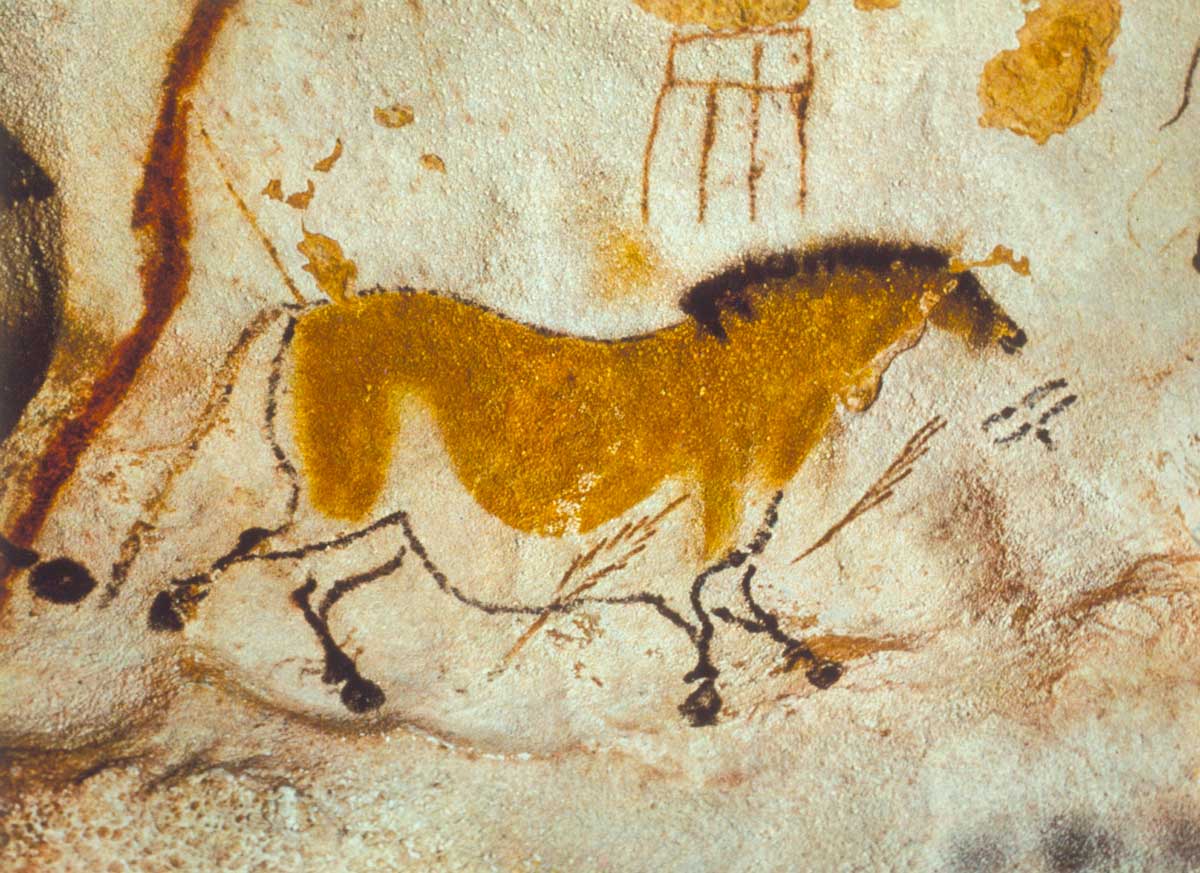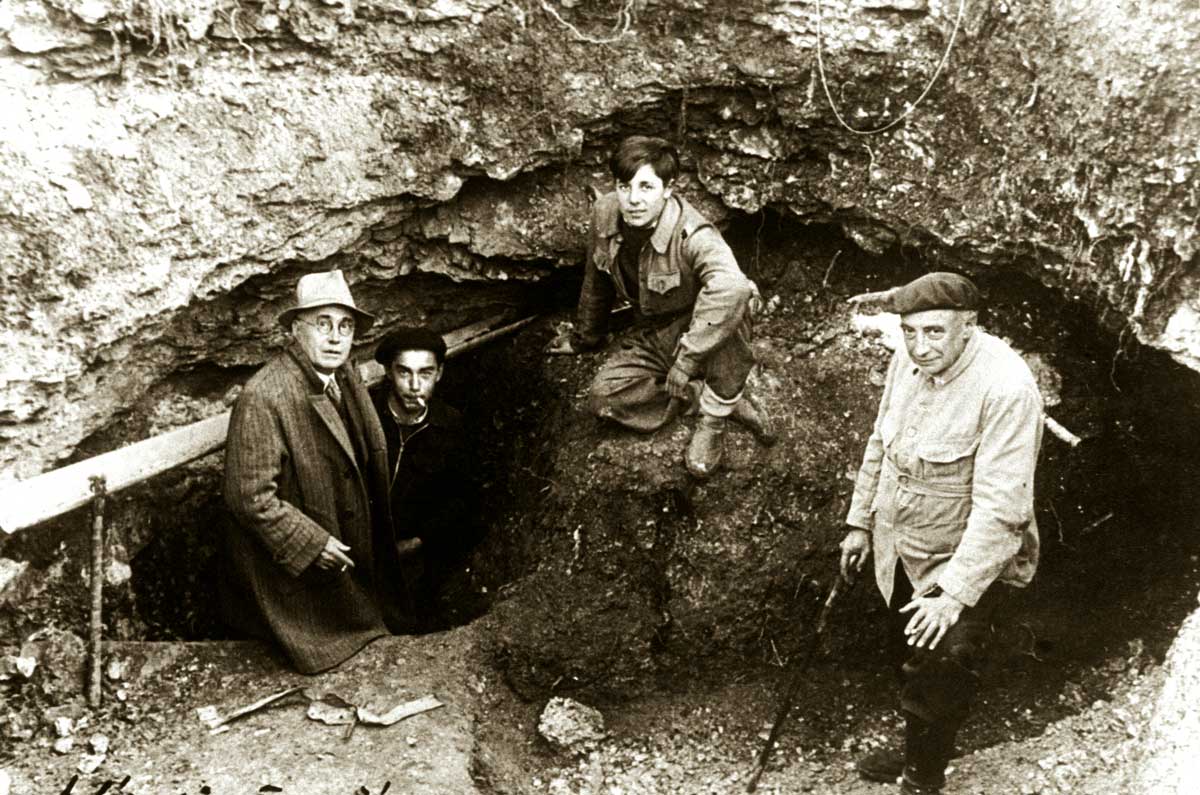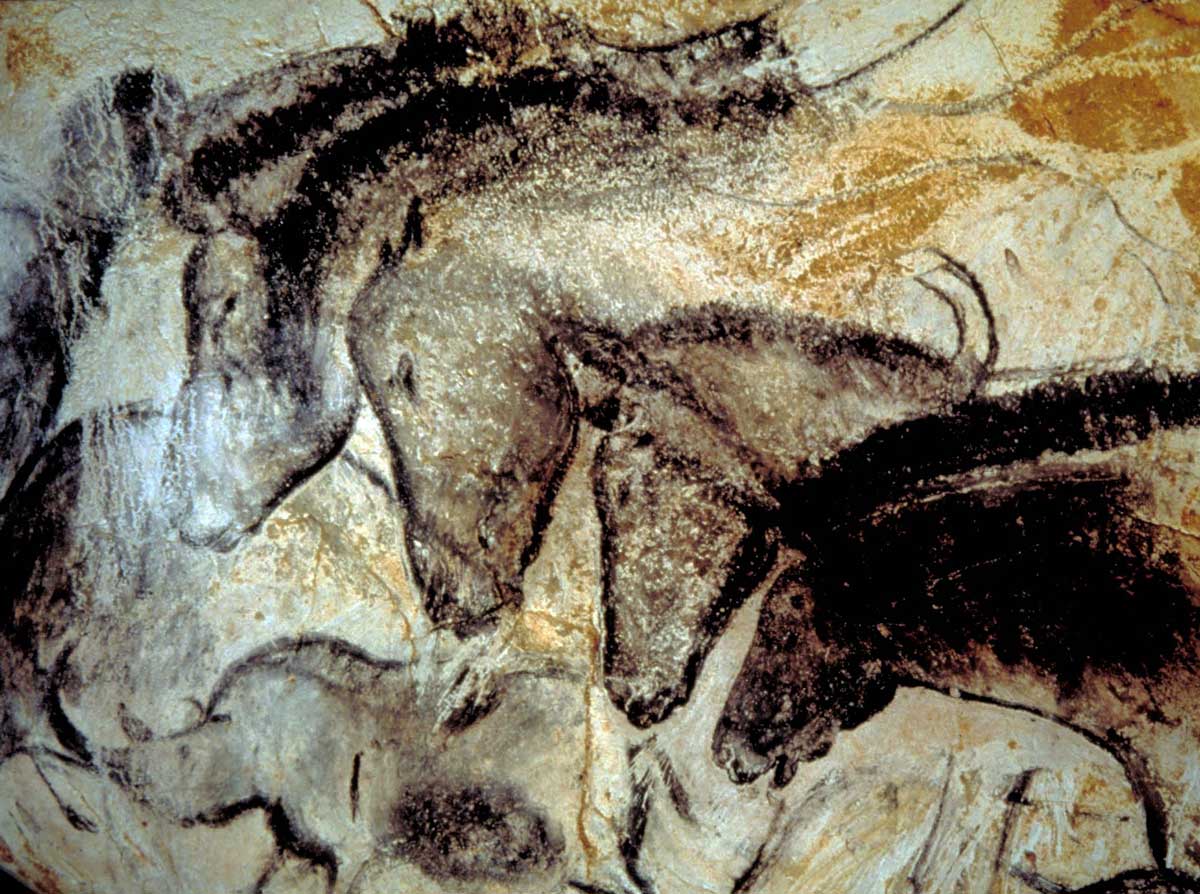Prehistoric Horses | History Today - 10 minutes read
On 8 September 1940, Marcel Ravidat was walking through the woods near his home in Montignac when his dog, Robot, suddenly disappeared. After a hasty search, Marcel found him at the bottom of a shallow pit. When Marcel jumped down to rescue the frightened dog, however, he noticed a small, very deep hole. His heart leapt. Legend had it that a secret tunnel leading to a nearby chateau was hidden somewhere around there – and he felt sure this was it. Four days later, he came back to explore with three friends. Squeezing through the narrow opening, they gingerly worked their way down a 15m shaft, until they found themselves standing in an enormous cave. At first, they struggled to see much by the pale light of their oil lamp. All of a sudden, one of them gave a cry and pointed at the wall. To their amazement, ranged along the length of the cavern was a vast cavalcade of animals, painted in the most vivid colours.
The Lascaux cave paintings, as they would soon be known, proved to be one of the most extensive and complete examples of Palaeolithic art in Europe, if not the world. Now dated to c.15000 BC they comprise a dazzling assortment of images, including some 6,000 representations of animals. Though painted by several different social groups, they are remarkable for the technical sophistication with which they were rendered. A range of pigments was used, including red hematite, yellow goethite, and black manganese. These were mixed with a binding agent, such as animal fat, clay, or water, to produce a rudimentary paint, or ground into a powder and ‘spat’ or blown onto the wall through a reindeer bone. Some of the paintings are so high that they can only have been reached using a specially built scaffold; while to produce others, the artists would have had to clamber down into a ‘well’.
A number of different animals are depicted, including stags, ibex, bison, aurochs (an extinct species of wild cattle), felines, a bear, a bird and even a rhinoceros. But by far the most common are horses. Unlike other creatures, which tend to be concentrated in certain places, horses are everywhere – and in huge numbers. By one estimate, they account for no less than 60 per cent of all identifiable animals in the Lascaux complex.
What is most striking about these horses is the intimate, even affectionate, familiarity with which they are portrayed. With their stocky build, short legs and spiky mane, they look similar to Przewalski’s horse, still found in Mongolia today. Though they are shown in a variety of different shades and patterns, most appear in their ‘mating’ coats, with dun-coloured hair and occasionally a pale or dappled underside. Some are standing, others are walking. More often than not, they are galloping – racing across the grasslands of prehistoric France, or fleeing an unseen foe.

The frequency with which they appear is puzzling, though. After all, horses were not domesticated until at least 10,000 years afterwards; and, though earlier cultures are known to have relied on them for both meat and hides, the same cannot be said for the communities which inhabited Lascaux. On the basis of bones found in the caves, it appears that reindeer were by far the most important source of food. Horses, by contrast, seem to have been rarely on the menu.
So why were the Lascaux painters so obsessed with them?
The cave before the horse
To answer this question, we first have to ask what purpose Palaeolithic cave paintings were meant to serve. This is a thorny problem, however. In the absence of any texts, which might give us a clear impression of the artists’ visual culture, belief system and relationship with the natural world, it is difficult to say anything about how the Lascaux cave paintings were meant to be understood, let alone why horses played such an important role in them. So difficult is it, in fact, that some archaeologists have questioned whether anything meaningful can be said about their function at all. According to Paul Bahn, it is a dubious enterprise at best. ‘If the artist’s testimony is unavailable’, he has argued, ‘the interpretation of the content of rock art is largely speculation, and to pretend otherwise is dishonest or an illusion.’ Others, however, are not so pessimistic. Emmanuel Anati, for example, has pointed out that, since Palaeolithic people were presumably able to understand the Lascaux cave paintings without recourse to anything beyond their own experience, we should be able to as well; it is just a matter of ‘getting into the right state of mind’.
But what is the ‘right state of mind’? And how should we ‘get into’ it?
Hunting magic
One of the earliest attempts to grapple with this problem was made by Abbé Henri Breuil. A pioneering scholar of Palaeolithic art, he was the first to study the Lascaux site systematically. In his view, the paintings could best be understood by analogy. Recognising that they had arisen from the daily experiences of a society that depended on hunting for its survival, he sought to explain their purpose by looking at how apparently similar cultures used such images in his own day. As an example, he chose the Arrernte people of central Australia. Though not alike in all respects, they, too, were hunter-gatherers, who frequently depicted animals in their rock art; and, since they viewed images as a form of ‘sympathetic magic’, Breuil assumed that the Lascaux painters had done the same.
The way it worked was simple. For Palaeolithic societies, Breuil argued, an image was the animal it represented – to such an extent that whatever happened on a cave wall would magically happen in real life. This was particularly true of the Lascaux horses. By painting pictures of horses being pierced by spears, Breuil claimed, the artists were ensuring the success of the next hunt. And in showing them in great herds, often in their mating coats, the hunters were willing there to be a plentiful supply of potential prey.

There were, however, two fundamental problems with this. On the one hand, Breuil’s comparison between the Arrernte and the Lascaux peoples seems dubious at best. While there may be a few superficial similarities between the two, it is difficult to believe that the practices of a modern Australian society share all that much in common with a Palaeolithic culture on the other side of the world. On the other hand, Breuil’s ideas about ‘sympathetic magic’ are difficult to reconcile with what we know about the animals depicted at Lascaux. As we have already seen, horses were simply not an important enough part of the creators’ diet to merit such ‘magical’ attention; while other animals, far from being prey, were positively dangerous. In one scene, a man is actually being killed by a bison – hardly the fate anyone would want to conjure up!
Structures and shamans
In the 1950s and 1960s, an alternative approach was proposed by Andrei Leroi-Gourhan and Annette Laming-Emperaire. In the belief that the cave paintings were a superficial expression of the deeper structures of thought characteristic of the society which created them, Leroi-Gourhan and Laming Emperaire attempted to look for hidden ‘patterns’ in the caverns and to attribute meaning to the distribution of abstract symbols and animal forms. On this basis, they suggested the cave could be read as the reflection of a spiritual world view based on the contrast between male and female. Thus, dots, dashes, bison and auroch were ‘masculine’ and ovals, squares, triangles and horses were ‘feminine’. That horses were shown in their ‘mating’ coats was hence testimony to a powerful association between women and fecundity; while the frequency of their appearance was probably due to the importance of reproduction and nurturing to an increasingly settled, if still vulnerable, society.
The sheer arbitrariness of the approach was, however, difficult to overlook. In the 1990s, therefore, a third interpretation was put forward by the South African archaeologist, David Lewis-Williams. This returned to the idea that the paintings might have had some magical qualities. In a ‘New Age’ twist, however, it was based as much on neurology as on analogy.
For Lewis-Williams, the key to the cave’s purpose lay in the abstract symbols. Noting that they were common to Palaeolithic art, he postulated that they were ‘form constants’ – geometric patterns commonly seen by people in a state of sensory deprivation or during drug-induced hallucinations. Since similar form constants commonly appear in images made by shamans – who often enter trance-like states for ritual purposes – he concluded that the Lascaux artists were likely to have been shamans, too. This suggested that the paintings were a record of the visual phenomena experienced during ceremonial ‘voyages’ to a spirit world – and that the animals represented the shadowy entities with which they sought to commune in the hope of healing sickness, changing the weather, or securing food. In this reading, horses would appear as a particularly important spirit, albeit one whose significance remains obscure.

Ingenious though it may be, however, Lewis-Williams’ ‘neurological’ approach is no more compelling than the others. Indeed, it actually combines the weaknesses of both. Not only is it wildly – even recklessly – conjectural, but the assumption of a common form of shamanism across millennia and continents seems untenable.
Equus
So where does this leave the horse? After decades of trying to read into the Lascaux paintings, archaeologists have recently begun looking around them – that is to say, at the caves. When confronted by the scale of the images, it is sometimes easy to forget that these were spaces occupied not only by artists, but also by reasonably large communities. They served as a site for butchering, eating, finding partners, raising children, recovering, remembering, learning and even teaching. And maybe this is all we really need to know. Imagine, for a moment, a Palaeolithic group seeking shelter in the cave after the hunt, huddling round the fire to discuss the day’s events, to share their hopes and fears, to try new things out, or to prepare their young for trials to come. What could have been more natural than to illustrate their talk with pictures – and to share in the making?
If such was their purpose, it would explain much about their visual choices. It would explain why they would have given so little space to animals like the reindeer, which they could already kill with ease, yet so much to those like the bison, which threatened them. It could also provide a reason for the presence of handprints, spear-like images and other geometrical shapes. But most importantly, it would account for the fascination with horses. Given that horses are known to have been killed, but only rarely and with difficulty, it is easy to see why their abundance, speed and mating season might have exercised such a potent hold over the imagination. Having seen herds galloping across the plains, how could these people not have longed to catch them? How could they not have marvelled at their swiftness and strength? Perhaps, by painting them, they were teaching, hoping, yearning. Perhaps they, like Peter Shaffer’s Equus, were simply crying out in love and defiance: ‘I am yours and you are mine.’
Alexander Lee is a fellow in the Centre for the Study of the Renaissance at the University of Warwick. His latest book is Machiavelli: His Life and Times (Picador, 2020).
Source: History Today Feed